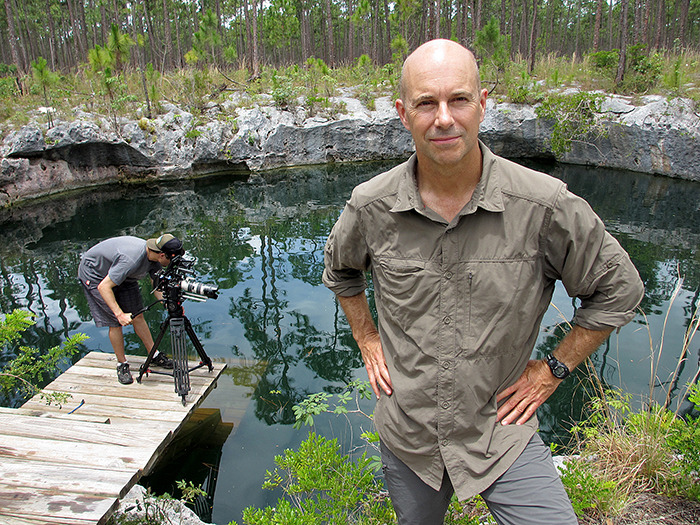
Image of diver in Canary Islands shot on Canon EOS-1D C. Credit: Peter Zuccarini
Parallax researcher Kate Webb interviewed Bahama Blue DOP Sean F. White about the cameras he is considering to shoot this groundbreaking wildlife series in 4K.
Buying a camera is always a big decision, but picking one compact enough to haul through swamps and jungles to shoot wildlife in ultra-high definition presents a dizzying array of considerations for cinematographer Sean White.
“I think the hardest part is comparing the different features of these cameras and scrutinizing them with a fine-toothed comb, and then really going back and trying to visualize whether it’s the right tool for the job,” he said.
Sean will primarily be using his camera to shoot creatures on the topside, such as flamingos, parrots and iguanas, but he also plans to swap gear while crisscrossing the tropical archipelago with acclaimed underwater cinematographer Peter Zuccarini, who already uses a Canon EOS-1D C.
Sean is currently weighing the pros and cons of three cameras: The Canon EOS-1D C, Canon EOS C500, and Red Epic-X.
Here’s what Sean had to say about each one:
Canon EOS-1D C

Pros: The 1D C is an option because it is a DSLR that also does video, so it’s super compact. With something like that you can just move and work faster. It does 4K video at 24 frames per second (FPS), and has the ability to record the HD signal on an external device, so for a HD production it makes a lot of sense. It’s also small enough that you can throw it in underwater housing and tote it around. It’s very versatile, and a lot less expensive than some of our other options.
Cons: I would only have 4K resolution at 24 FPS — it doesn’t have any higher frame rates than that — and it would have to be set it up with a top-quality external recorder.
Canon EOS C500

Pros: The C500 has an excellent reputation for low light, is 4K capable, and compatible with the lenses we already own. It has the audio features built in, and people like the look of this camera. It’s also at a good price point.
Cons: As a 4K camera it wouldn’t give us the option of high frame rates and we would need to kit it out it to get maximum potential out of it.
Red Epic-X

Pros: The Red is sort of the gold standard, in the sense that it can do everything. It does the high resolution, multiple resolutions and multiple frame rates. These are major considerations for us and you can set it up for still lenses. The Red Epic-X also shoots in a raw format so you have more control of the image in post-production. And it’s small and compact enough that we could kit it out and customize it to fit our needs.
Cons: It’s expensive, and would require additional data storage if we do RAW recording. That means more steps in post-production to process images. Kitting out would require additional audio, ND filter control, batteries, and a viewfinder.
Which camera do you think Sean should choose? Leave a comment on our Facebook page with your thoughts, and check back here next week to find out his final decision!


Comments are Closed.